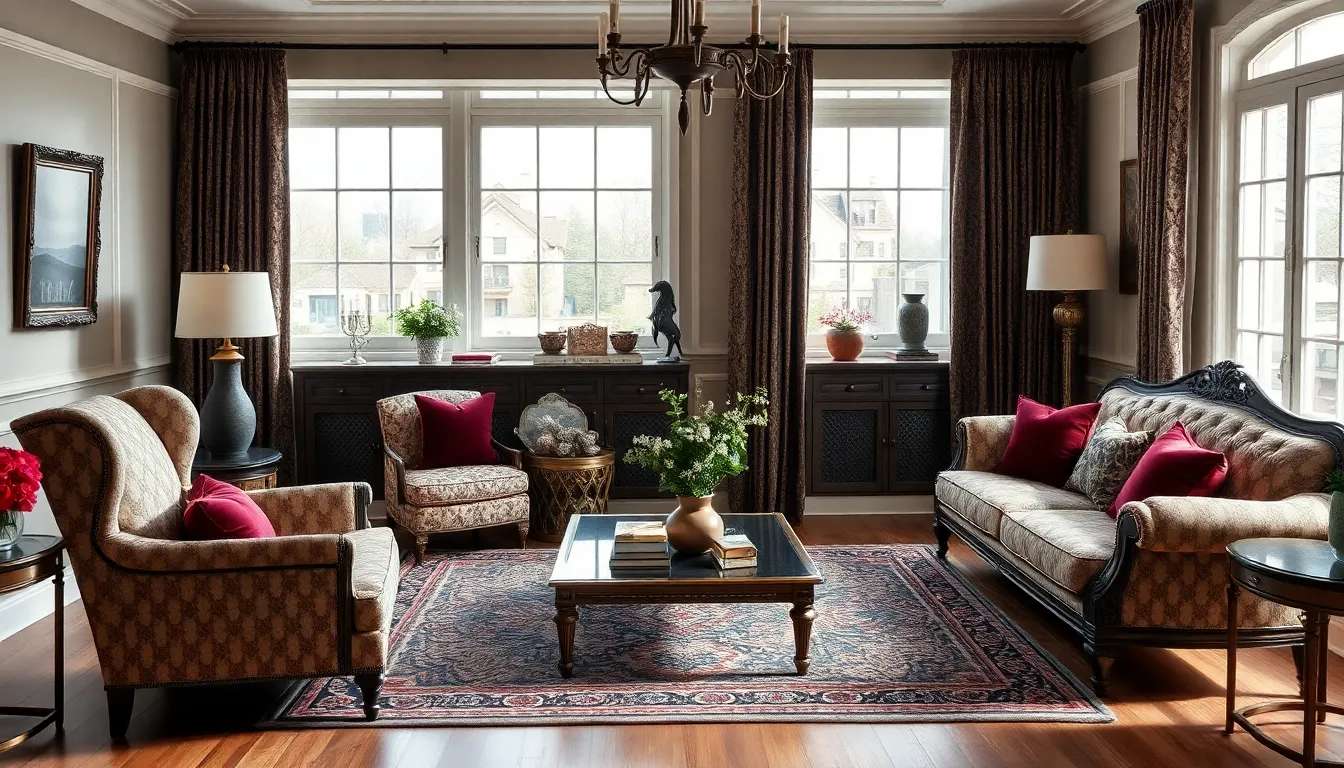Table of Contents
ToggleClassic interior design isn’t just a style; it’s a timeless embrace of elegance that whispers sophistication in every corner. Imagine walking into a room where rich fabrics meet intricate moldings, and every piece tells a story. It’s like stepping into a Jane Austen novel, minus the drama (unless you count your cat knocking over a vase).
Overview of Classic Interior Design
Classic interior design embodies timeless elegance and sophistication. This style draws inspiration from historical periods, often reflecting the grandeur of French, Italian, or English design. Rich fabrics such as silk and velvet enhance the luxurious feel, while intricate moldings and detailed woodwork add depth to spaces.
Complements of classic design include well-proportioned furniture pieces that radiate comfort and refinement. Each item, from tufted sofas to ornate tables, contributes significantly to the overall aesthetic, creating a harmonious environment. Detailed architectural elements, such as crown molding and coffered ceilings, elevate the sense of upscale living.
Color palettes tend to feature neutral bases, accented with deep jewel tones or pastels. This approach allows for versatility and can adapt to various preferences. Textures also play a crucial role, with a mix of polished surfaces and soft fabrics that engage both the eye and touch.
Lighting in classic interiors often encompasses chandeliers or ornate sconces that provide a warm glow. Natural light is maximized with heavy drapery that can be drawn aside or left open to create an inviting ambiance. Accessories, including antique vases or framed art, complete the look with personal flair.
Attention to detail remains paramount in classic design. Every choice matters, from the selection of decorative pillows to the arrangement of books on a shelf. Overall, classic interior design paints a portrait of refined living that balances tradition with individual expression.
Key Elements of Classic Interior Design

Classic interior design features a blend of historical influence and timeless elegance. Key components include color palettes, furniture styles, and textiles that come together to create an inviting atmosphere.
Color Palette
A classic interior design color palette often consists of muted hues paired with rich tones. Neutrals like beige, cream, and gray provide a backdrop that enhances other elements. Deep colors like navy, forest green, and burgundy add sophistication when used thoughtfully. Accents in gold or silver can elevate the overall aesthetic, bringing warmth and a sense of luxury. Balance is critical, so colors should complement rather than overwhelm.
Furniture Styles
Furniture styles in classic interior design prioritize timeless elegance and comfort. Traditional pieces often include items like wingback chairs and ornate sofas that invite relaxation. These furniture options feature smooth lines and intricate carvings, emphasizing craftsmanship. A blend of styles, including Baroque and Federal, introduces visual interest; variety creates a harmonious look. Mixing wood finishes, such as mahogany or cherry, accentuates warmth while ensuring each piece contributes to the overall design.
Textiles and Fabrics
Textiles and fabrics play a crucial role in classic interiors, enhancing both comfort and style. Luxurious options like silk, velvet, and damask elevate the aesthetic and invite touch. Draperies often feature rich patterns or textures, framing windows elegantly. Throw pillows and area rugs in complementary colors add depth and warmth to rooms. Attention to detail in fabric choices ensures a cohesive look and reinforces the theme of sophistication ideal for classic spaces.
Famous Classic Interior Design Styles
Classic interior design comprises several distinctive styles, each with unique characteristics and historical significance. Understanding these styles provides inspiration for creating timeless and elegant spaces.
Georgian
Georgian style emphasizes symmetry and proportion, borrowing inspiration from classical architecture. This style showcases large windows, ornate moldings, and high ceilings. Often, it features a color palette of soft pastels combined with rich jewel tones. Furniture stands out for its craftsmanship and includes items like mahogany sideboards and upholstered chairs. Decor often includes wallpaper with intricate patterns, reflecting the era’s attention to detail. Accessories are carefully chosen, with pieces such as crystal chandeliers that add elegance to the space.
Victorian
Victorian design epitomizes opulence with its lavish colors and intricate patterns. During the Victorian era, mixing styles became popular, creating spaces filled with an array of textures and motifs. Rich fabrics like brocade and damask dominate upholstery. Furniture displays elaborate details, and items such as tufted sofas and carved wooden tables are common. Ornate drapery frames windows, adding to the lavish feel. Artwork often features landscape scenes or portraits, enhancing the opulent ambiance typical of this style.
French Country
French Country style embodies rustic charm and warmth, characterized by natural materials and cozy furnishings. Wooden beams and stone walls create a warm atmosphere, while exposed beams highlight the architectural features. Soft colors such as creams, muted blues, and warm greens enhance the relaxed feel. Antique furniture complements the decor, with pieces like farmhouse tables and distressed cabinets contributing to the inviting ambiance. Textiles such as linen and toile enhance comfort, often seen in tablecloths and slipcovers. Decorative accents might include ceramics and wrought iron, adding to the rustic elegance of the space.
Benefits of Classic Interior Design
Classic interior design offers numerous advantages that resonate with both aesthetic appeal and functionality. Timeless elegance stands at the forefront, as this style doesn’t follow fleeting trends and instead provides lasting beauty. It enhances property value, making spaces more attractive to potential buyers and renters, ensuring a strong return on investment.
Comfort is also a key benefit. Thoughtfully selected furniture pieces prioritize not just style but also comfort, inviting relaxation and enjoyment. Rich textiles, including silk and velvet, add softness while also showcasing quality craftsmanship. Each element curated creates a welcoming atmosphere rooted in sophistication.
Cohesion of design elements marks another advantage. A well-executed classic design maintains a harmonious balance between color palettes, furniture styles, and accessories. This seamless integration fosters a peaceful and refined environment, ideal for both casual gatherings and formal occasions.
Flexibility in decor choices allows personal expression. Classic interior design accommodates a variety of personal tastes, with each homeowner’s selections adding individuality. From choice of artwork to the inclusion of family heirlooms, these choices imbue spaces with character.
Sustainability often features as an important aspect. Utilizing high-quality materials leads to durability, meaning furnishings can endure through years without losing appeal. Focusing on craftsmanship supports eco-friendly practices, aligning with modern desires for sustainable living.
Visual storytelling captures the essence of classic design. Each piece and accessory carries historical significance, creating a narrative that invites exploration. This dynamic invites appreciation not just for beauty but for the stories each item tells.
These benefits illustrate how classic interior design contributes to well-being, enhancing the overall experience of living spaces.
Classic interior design stands as a testament to elegance and sophistication. Its rich fabrics and intricate details create spaces that are not only beautiful but also inviting. This style embodies a perfect blend of history and personal expression, allowing homeowners to craft environments that reflect their unique tastes while honoring timeless traditions.
The focus on quality materials and thoughtful design choices ensures that classic interiors remain relevant and appealing across generations. With its ability to enhance comfort and property value, classic design continues to be a popular choice for those seeking to create a refined living space. Ultimately, it invites individuals to appreciate the artistry and stories behind each carefully curated element.




